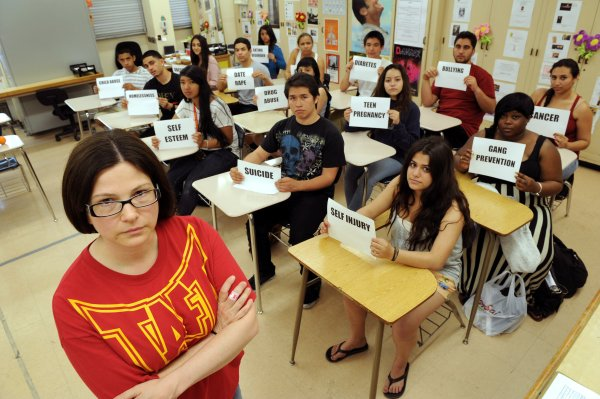Promoting healthy and safe behaviors among students is an important part of the mission of schools. A popular truism is that “healthy students are better learners.” The question is how do we ensure that our students are best prepared and engaged in the process of being healthy students and better learners, now and in the future. There is compelling research evidence that quality health education programs, provided to students throughout their public school experience, is a critically important key.
The Center for Disease Control and Prevention’s (CDC) Whole School, Whole Community, Whole Child (WSCC) model recognizes the critical role that health education has within the school setting. Effective health education provides students with the knowledge and skills needed to make healthy life choices, and is the foundation for having a productive and healthy lifestyle in the future. Its publication, “Health and Academic Achievement Overview,” reported that students, whose needs for health and well-being are addressed, are more likely to:
- attend school regularly
- behave well
- be physically fit and mentally alert
- be better learners
- graduate from high school
- grow into healthy, resilient and productive adults
Health education should motivate students to improve and/or maintain their health, prevent disease and reduce risky behaviors. Classroom activities to develop communication, decision-making, problem-solving and goal setting skills, helps strengthen students’ self-esteem and resiliency capabilities.
The Health Education Curriculum Analysis Tool (HECAT), a CDC resource publication, can help schools develop or select and deliver a quality health education curriculum. Health education should be taught by a credentialed Health and Physical Education teacher who participates in at least one health-related professional development annually.
In the United States, chronic diseases are the leading cause of morbidity and mortality. Health risk behaviors that contribute to these leading causes of death are often developed during childhood. Prevention is the best deterrent for chronic disease. Additionally, health literacy – the capacity to obtain, interpret and understand basic health information and services in ways which are health enhancing – is ensured when “education about health is part of the curriculum in all levels of education.” (Institute of Medicine, 2004)
New Jersey
Health education and safety is frequently the least prioritized and most marginalized “subject” in many schools; however, the lessons imparted have the potential to impact an individual’s quality of life for their entire life. Students in New Jersey public schools are required to receive Physical Education and Health classes. New Jersey Core Curriculum Content Standards (NJCCCS) mandate that every student receive a minimum of 150 minutes of health, safety and physical education per week. Local school districts are able to determine how many minutes are necessary to address each component effectively.
Based on the NJCCCS and National Health Education Standards, quality Health Education Programs should be: 1) comprehensive 2) sequential 3) age appropriate 4) emphasizing the natural interdisciplinary connection between wellness, health and physical education and 5) graded as other academic subjects are graded. According to NJDOE Model Curriculum in Health and Physical Education, a quality health education:
- provides a planned curriculum, instruction and activities for all students throughout the entire year
- fosters a physically active lifestyle
- encourages students to increase their knowledge of health and wellness and how it will affect their lives
- gives students the foundation to maintain their physical, social and emotional health
- provides an opportunity for every student to learn and achieve
- engages students in communication skills such as problem solving, negotiation, and conflict resolution
- assists students in being advocates for personal, family, community and global wellness
Additionally, structured lessons should scaffold instruction from one grade level to the next. There are four components that New Jersey health education programs are required to teach: 1) Wellness 2) Alcohol, Tobacco and Other Drugs 3) Family Life and 4) Community Health Skills.
Conclusion
School health education provides the fundamental basis for inspiring attitudes, instilling knowledge and motivating behaviors in our youth. If we want to keep our children and adolescents healthy, it is paramount that a quality health education curriculum be taught. The recent federal enactment of the “Every Student Succeeds Act (ESSA)” brings great hope that this Act will have a significant and positive impact on the quality of health education provided to all students.
Sources:
U.S. Center for Disease Control and Prevention, Division of Population Health. “Health and Academic Achievement Overview”, May 2014
U.S. Center for Disease Control and Prevention, School Health Index
U.S. Center for Disease Control and Prevention, Health Education Analysis Tool (HECAT)
The American Diabetes Association – Health Education in Schools – The Importance of Establishing Healthy Behaviors in our Nations’ Youth
U.S. Department of Health and Human Services. Healthy Youth: An Investment in our Nation’s Future, 2007. Atlanta, GA
U.S. Department of Health and Human Services, CDC Coordinating Center for Health Promotion: 2007
World Health Organization. Information series on school health: Skills for health; 2003
U.S. Center for Disease Control and Prevention, National Health Education Standards
New Jersey Department of Education Core Curriculum Content Standards – Comprehensive Health and Physical Education
New Jersey Department of Education, Model Curriculum in Health and Physical Education
Institute of Medicine. Health Literacy: A Prescription to End Confusion
American School Health Association, Connecting Health and Learning, Position Statement: The Every Student Succeeds Act: Implications for K-12 Health Education and Physical Education
New Jersey Department of Education, Shifting Gear: Improving Student Achievement in Health and Physical Education, Brendan O’Reilly




